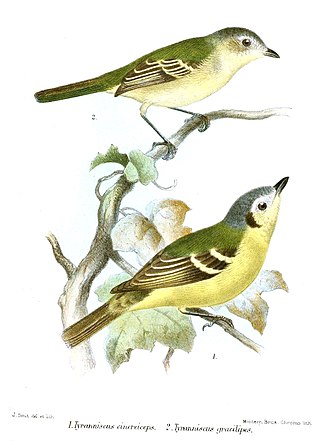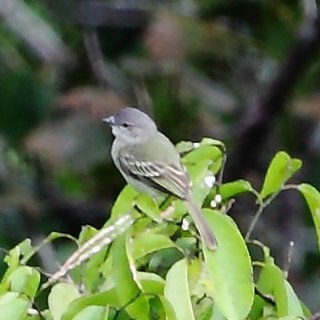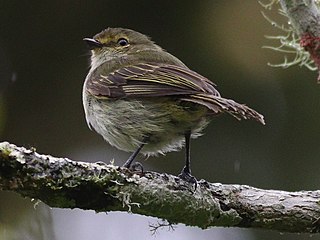
The Amazonian black-throated trogon is a bird in the family Trogonidae, the trogons and quetzals. Although it has also been called "yellow-bellied trogon" it is not the only trogon with a yellow belly. It is found in every mainland South American country except Argentina, Chile, Paraguay, and Uruguay.

The pale-tipped inezia, or pale-tipped tyrannulet, is a species of bird in the family Tyrannidae, the tyrant flycatchers. It is found in Brazil, Colombia, French Guiana, Guyana, Suriname, and Venezuela.

The grey antbird is a species of bird in subfamily Thamnophilinae of family Thamnophilidae, the "typical antbirds". It is found in Bolivia, Brazil, Colombia, Ecuador, French Guiana, Guyana, Peru, Suriname, and Venezuela.

The plain inezia, or plain tyrannulet, is a species of passerine bird in the family Tyrannidae, the tyrant flycatchers. It is found in Argentina, Bolivia, Brazil, Paraguay, and Peru.

The slender-billed inezia, or slender-billed tyrannulet, is a species of bird in the family Tyrannidae, the tyrant flycatchers. It is found in Colombia and Venezuela.

The white-throated tyrannulet is a species of bird in subfamily Elaeniinae of family Tyrannidae, the tyrant flycatchers. It is found in Argentina, Bolivia, Brazil, Colombia, Ecuador, Peru, and Venezuela.

The southern mouse-colored tyrannulet is a species of bird in subfamily Elaeniinae of family Tyrannidae, the tyrant flycatchers. It is found in Argentina, Bolivia, Brazil, Paraguay, Peru, and possibly French Guiana and Suriname.

Urich's tyrannulet is an Endangered species of bird in subfamily Elaeniinae of family Tyrannidae, the tyrant flycatchers. It is endemic to Venezuela.

Chapman's bristle tyrant, also known as Chapman's tyrannulet, is a species of passerine bird in the family Tyrannidae, the tyrant flycatchers. It is found in Brazil, Guyana, and Venezuela.

The Panama tyrannulet or yellow-green tyrannulet is a species of bird in the family Tyrannidae, the tyrant flycatchers. It is endemic to Panama.

The mottle-cheeked tyrannulet is a generally common, small species of bird in the family Tyrannidae, the tyrant flycatchers. It is found in Argentina, Bolivia, Brazil, Paraguay, Peru, and Uruguay.

The black-tailed leaftosser is a species of bird in the subfamily Sclerurinae, the leaftossers and miners, of the ovenbird family Furnariidae. It is found in Bolivia, Brazil, Colombia, Ecuador, French Guiana, Guyana, Peru, Suriname, and Venezuela.

The northern scrub flycatcher is a species of bird in the family Tyrannidae, the tyrant flycatchers. It is found in Aruba, Bonaire, Colombia, Costa Rica, Curaçao, French Guiana, Guyana, Panama, Suriname, Trinidad, and Venezuela.

The Amazonian scrub flycatcher or Todd's scrub flycatcher is a species of bird in the family Tyrannidae, the tyrant flycatchers. It is found in every mainland South American country except Argentina, Chile, Paraguay, and Uruguay.

The Amazonian antshrike is a species of bird in subfamily Thamnophilinae of family Thamnophilidae, the "typical antbirds". It is found in every mainland South American country except Argentina, Chile, Paraguay, and Uruguay.

The slender-footed tyrannulet is a species of bird in the family Tyrannidae, the tyrant flycatchers. It is found in Bolivia, Brazil, Colombia, Ecuador, Peru, and Venezuela.

The Guianan tyrannulet is a species of bird in the family Tyrannidae, the tyrant flycatchers. It is found in Brazil, French Guiana, Guyana, Suriname, and Venezuela.

The Choco tyrannulet is a species of bird in the family Tyrannidae, the tyrant flycatchers. It is found in Colombia and Ecuador.

The white-fronted tyrannulet is a species of bird in subfamily Elaeniinae of family Tyrannidae, the tyrant flycatchers. It is found in Bolivia, Colombia, Costa Rica, Ecuador, Panama, Peru, and Venezuela.

Coopmans's tyrannulet is a species of bird in the family Tyrannidae, the tyrant flycatchers. It is found in Colombia and Venezuela.























